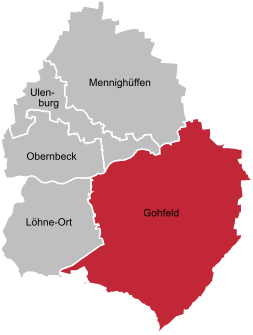Gohfeld
|
Gohfeld
City of wages
Coordinates: 52 ° 11 ′ 35 ″ N , 8 ° 45 ′ 31 ″ E
|
|
|---|---|
| Height : | 71 (48-177) m |
| Area : | 25.5 km² (with Löhne train station) |
| Residents : | 18,642 (Dec. 31, 2003) |
| Population density : | 731 inhabitants / km² |
| Incorporation : | 1st January 1969 |
| Postal code : | 32584 |
| Area code : | 05731 |
|
Location of Gohfeld in Löhne
|
|
Gohfeld is a district of the city of Löhne in northeast North Rhine-Westphalia . Until it was founded in 1969, the place formed its own community . Today, however, only the eastern part of the former municipality is often referred to as Gohfeld, while the west, officially part of Gohfeld, is referred to as Löhne-Bahnhof , represents its own unofficial district and is therefore not included here.
Location and districts
Gohfeld makes up the east and south-east of the Löhn city area. Adjacent neighborhoods are wages Station in the west and Mennighüffen besides Ulenburg in the northwest. Otherwise, Bad Oeynhausen with Werste , Innenstadt and Lohe join in the north and east , Vlotho - Exter in the south-east and Herford - Schwarzenmoor in the south-west .
The district is located on the south bank of the Werre . The cores of the districts Depenbrock , Jöllenbeck and Melbergen are located on their flood-proof terrace . To the south the terrain rises noticeably and is criss-crossed by several sieks . The district of Wittel can be found here .
Gohfeld is densely populated and has largely grown together with neighboring Bad Oeynhausen. The population cannot be determined precisely because Gohfeld and Löhne-Bahnhof are combined in the statistics. For a rough orientation, however, one can assume around two thirds of the common value (December 31, 2003: 18,642), i.e. around 12,500 inhabitants.
history
The separate development of Gohfeld and Löhne-Bahnhof goes back to the settlement development since the 19th century. After a large marshalling yard and transfer station was built in the western area of the former Gohfeld community , a separate settlement focus developed here with an impact on the surrounding communities, the name Löhne-Bahnhof became established. The Gohfeld core area in the east, on the other hand, increasingly focused on the up-and-coming neighboring town of Bad Oeynhausen.
Cheruscans and Chasuarians were the first to settle in the area. After the end of the migration, around 400 Saxons settled there. Around 800 the area was Christianized by the Franks. The first written mention of the district Jöllenbeck is proven for 993, the name Gohfeld was mentioned for the first time in 1224.
In 1338 there is evidence of a parish church in Gohfeld. The Lutheran Reformation also took place in Gohfeld around 1550 . A plague epidemic raged in 1636 , and records began in the church registers in the same year . In 1654–1656 21 women were accused of witchcraft and burned at the castle at Hausberge . In 1735 the New Church was inaugurated, it was a gift from the Prussian King Friedrich Wilhelm I. For 1751–1771 the work of Pastor Friedrich August Weihe, a representative of Pietism , is proven.
In the battle near Gohfeld in 1759, a sideline to the battle of Minden , 10,000 Hanoverians and allies under Karl Wilhelm Ferdinand of Braunschweig defeat 4,000 French under Duke Jean-Paul-Timoléon von Brissac . Part of the battlefield has been called the “blood meadow” since then.
In 1806 Gohfeld fell to the French-controlled Kingdom of Westphalia , administrative unit of the Weser department . In the year 1813, the Russians (General von Winzigrode, 42,000 men) and the Prussians (General Bülow von Dennewitz, 30,000 men) marched through the troops.
In 1847 the Cologne-Minden Railway was built immediately north of the old settlement centers. After the construction of the southern railway in the direction of Hameln in 1875, the Gohfeld core area is now between two railway embankments.
Pastor Eduard Kuhlo, the founder of the Protestant trombone choir with his son Johannes Kuhlo , worked in Gohfeld from 1854 to 1891. In 1964 the new Wittel parish was founded and the Lukaskirche was built.
, As part of the pending aspirations NRW - municipal reform Gohfeld partially or completely to connect to Bad Oeynhausen, failing to 1,967 of the resistance of local politicians laborers. On January 1, 1969, Gohfeld was incorporated into Löhne.
In 1992 the last train stopped at the station in Gohfeld, which was then closed. In 1993 Gohfeld celebrated the 1000th anniversary of the town. The Evangelical School for Home Economics and Nutrition (popularly called "Pudding School") was closed by the Evangelische Frauenhilfe Westfalen in 1994. The last headmistress was Barbara Hänsch .
In 2000, the Bad Oeynhausen / Löhne 2000 state horticultural show took place as a joint event with Bad Oeynhausen on a former brick factory in Gohfeld. Today there is the landscape and culture park Aqua Magica .
traffic
The near railroad tracks Hamm-Minden and wages-Rheine located station Gohfeld is closed. The district can be reached with a few bus lines (430, 437 and 438) from Löhne train station and Bad Oeynhausen.
schools
- Gohfeld primary school
- Melbergen-Wittel primary school
- Goethe Realschule
Kindergartens
- Plumpaquatsch, integrative kindergarten run by a parents' initiative
Parishes
- Evangelical Lutheran Parish Gohfeld
- Evangelical parish Wittel
Web links
Individual evidence
- ↑ Martin Bünermann: The communities of the first reorganization program in North Rhine-Westphalia . Deutscher Gemeindeverlag, Cologne 1970, p. 75 .


